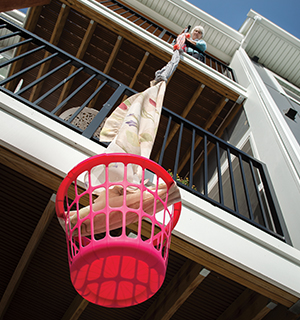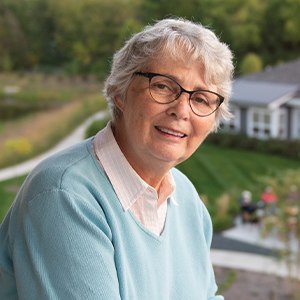Jan Lage, a resident at Brio, a WesleyLife community in Johnston.
Writer: Rachel Vogel Quinn
Photographer: Duane Tinkey
As an active and social woman, Jan Lage, 76, sometimes feels like Rapunzel trapped in her tower.
Before the pandemic, she would pick up her grandkids from school and cheer at their basketball and soccer games. At her residence Brio of Johnston (a WesleyLife Community), she joined group exercise classes, attended musical performances, and enjoyed visits from neighbors.

Now, she is alone.
“When the door closes, it’s just me,” Lage says.
She moved to Brio just six months before the pandemic. During lockdown, her twin 11-year-old granddaughters would bike over and peer up at her third-floor balcony. To interact with them, Lage created “Rapunzel,” a plastic basket she could lower on a rope of knotted scarves. Sometimes they swapped treats, exchanging ice cream for Rice Krispies. Rapunzel gave Lage limited access to the outside world, allowing her to feed a horse who came to visit residents and to retrieve a piece of wedding cake from a newlywed staff member.
With pandemic protocols in place, Lage says dinnertime is the worst part of every day. Within 10 minutes, she’s finished her hand-delivered meal and cleaned up the mess.
“Who can you talk to?” she asks. “You can talk to your plants, you say hi to the people who bring you food. But you don’t have any real connection.”
A Loneliness Epidemic
Lage is far from alone in feeling lonely: According to an April 2020 survey by SocialPro.com, one-third of Americans reported feeling lonelier than usual since the pandemic began.
“Humans don’t do well by themselves,” says Dr. Stephen Mandler, chief medical officer of Orchard Place. “We evolved to be in the presence of other people and to interact regularly.”
Social distancing may have exacerbated loneliness, but the term is not synonymous with physical isolation. Solitude can be rejuvenating. And some people feel lonely even when they’re surrounded by others. Loneliness is the state of distress or discomfort we experience when we imagine that we face the world by ourselves.
Mandler says that the body responds to loneliness as if it’s in danger: “We become vigilant. We become sensitive. We start to grieve.”
When these feelings extend for a long period of time, we can enter a state of chronic loneliness, leading to low self-esteem and self-loathing. Research by famed University of Chicago psychologist John Cacioppo found lonely people experience more stress even when they’re relaxing.
All that stress takes a physical toll. The gastrointestinal system is one of the first affected, Mandler says. Over time, higher stress hormones associated with loneliness can increase blood pressure, damage arteries, and even affect memory. Loneliness is also a harbinger of mental health issues such as depression and alcohol addiction.
Fortunately, simple loneliness is not a reason for despair. A little outreach can start eroding negative feelings. In a 2018 German study, people who focused on spending more time with others over a year increased life satisfaction, while those who tried other strategies, like kicking bad habits, showed no change.
In truth, our tendency toward loneliness isn’t the weakness we imagine it to be. Experts say the flip side of loneliness is our immense capacity for connection, joy and love. Our social drive is something to be savored. Without it, we might never feel lonely. But we also wouldn’t have each other.
Kids on the Sidelines
In normal times, children are surrounded by classmates, teammates and friends—not to mention adult family members, teachers and other caregivers. Virtual schooling and the cancellation of group activities have interrupted relationships crucial for childhood development.
“A child might not recognize that they’re feeling stressed,” Mandler says. “And they are not necessarily going to feel sad when they’re lonely.”
Instead, Mandler explains, children may express loneliness through irritability and overreaction. Kids actively involved with sports and group activities are struggling the most right now, he says, because they don’t know what to do with their time. Even Mandler’s own son has lost track of the days.
To help lonely children, parents need to re-establish schedules and routines, he suggests. Consistent meal times and bedtimes have deteriorated for many families during the pandemic. But these rituals are incredibly important for children. Mandler advises parents to create visual charts mapping out each day, with changes explained in advance.
Mandler also encourages parents to limit screen time. The American Academy of Pediatrics recommends keeping it under two hours a day. If that’s not realistic, Mandler says, try to reduce current levels.
Although close relationships are important for children, Mandler emphasizes that a single best friend can be enough. Don’t be concerned if your child isn’t the life of the party; instead, help him or her develop relationships they already have.
Solitary Seniors
Older adults are particularly susceptible to loneliness and its associated health risks, as in Lage’s situation at Brio. According to the National Institute for Health Care Management, lonely seniors are 45% more likely to die. But they can also find refuge in senior living communities, with access to friendly peers and regular social events. Unfortunately, the pandemic has turned many of these centers into isolated islands.
“I don’t think the outside world really knows how much senior living communities have changed,” says Lindsey Loftsgard, Brio’s lifestyle director.
Before the pandemic, Loftsgard helped organize daily activities including cultural programs, musical performances, lectures, social gatherings and outings around the metro. But the pandemic stopped all that.
Although Brio has seen a few cases of COVID-19, the community has been spared a large outbreak. Still, the safety precautions mean residents are staying in their rooms much more than usual.
Restrictions on visitors have been especially hard for residents. To solve the problem, Loftsgard and her team created “window boxes,” clear plexiglass walls that separate residents from visiting friends and family. “It’s just amazing how much their day changes after they see their family,” Loftsgard says.
The window boxes have allowed spouses living in different levels of care to see each other for the first time in months. Loftsgard recounts “heart-melting” scenes of husbands and wives touching and kissing on either side of the glass.
“Being able to connect with your family boosts your mood,” Loftsgard says. “It makes you happier. It makes you want to get out of your room more.”
Loftsgard advises family members to reach out to older loved ones on a daily basis. She says calling is better than texting, and written letters are extra special, especially if they include photos or children’s drawings.
The staff at Brio has gotten creative keeping residents engaged and connected. They started virtual programming, with multiple video series featuring staff and residents. Their newest, called Brio on the Go, follows staff members in their lives outside work. Loftsgard can’t wait to attach a GoPro to her golden retriever for a dog-led bike ride.
For Brio residents who might fancy a cycling trip themselves, the staff purchased an all-ability bike. Loftsgard loves surprising wheelchair-using residents with a bike ride. The wheelchair straps to a ramp in front, and Loftsgard pedals behind, with an assist from an electric motor.
She tells those craving a glimpse of the outside world: “We’ll do all the work. You just relax and enjoy the ride.”
One Day at a Time
 When Jan Lage moved to Brio, she immediately started making connections with other residents, sitting outside her door for neighborly chats and lingering over dinner conversation for hours. Originally from Des Moines, she returned to the metro in 2006 to be closer to her four grandkids.
When Jan Lage moved to Brio, she immediately started making connections with other residents, sitting outside her door for neighborly chats and lingering over dinner conversation for hours. Originally from Des Moines, she returned to the metro in 2006 to be closer to her four grandkids.
Although Lage appreciates the way WesleyLife is keeping residents safe—and raves about the creativity and support of the staff—she says living in quarantine can sometimes feel like a jail sentence. She misses physical touch, especially hugs from her grandchildren. Pleased that COVID-19 has largely spared Brio residents, she wonders how the side effects of the pandemic have affected older adults nationwide. She ponders: How many seniors have died from health issues exacerbated by loneliness?
Fortunately, Lage’s own health hasn’t suffered, and she strives to keep a positive attitude. Seeing friends and neighbors in the hall, she can tell who is having a bad day and stops to offer comfort.
“You have to take every day one at a time,” Lage says. “You can’t think ahead because you don’t know what’s ahead.”
As a person who plans her day the night before, Lage has focused on filling her schedule with solo activities: taking long walks around Johnston, cleaning her apartment, exercising, playing Sudoku. Tired of watching TV and out of books to read, she says the puzzles keep her brain busy.
“If they would look at us before and after the pandemic, I think they would find differences in how the brain is working,” Lage muses.
Because she regrets time she spent sitting early in the pandemic, Lage has committed to staying active and upright. In August, as restrictions at Brio began to ease, she took her granddaughters shopping one by one for school supplies. Also in August, residents could gather in the courtyard in small groups for mid-afternoon chats.
“You have to have somebody to count on,” says Lage. “You have to have family. Family is not just my family. Family is the people I am with here.”
Loneliness by the Numbers
- Nearly 80% of Generation Z and 70% of Millennials report feeling lonely, compared to 50% of Baby Boomers. Twenty-two percent of Gen Xers always or often feel more lonely because of COVID-19.
- People with greater social interaction have a 50% lower risk of early death.
- Chronic loneliness can lead to reduced cognitive skills, depression, sleep disorders, type 2 diabetes, heart disease, high blood pressure and substance abuse.
- $6.7 billion in annual Medicare spending can be attributed to the health effects of social isolation among older adults.
- Lonely workers are twice as likely to miss work due to illness and 5 times more likely to miss work due to stress.
- 73% of “very heavy” social media users are lonely, compared to 52% of light users.
Sources: Cigna, Loneliness and the Workplace – 2020 U.S. Report; Holt-Lunstad, 2010; Cigna, 2019; CareMore Health, 2019.
13 Ways to Reduce Loneliness
Try these tips to keep loneliness at bay—and kindle contentment during your alone time.
- Remind yourself that it’s a normal human emotion. There is nothing wrong with you.
- Be kind to yourself. Try to cut back on negative thoughts.
- Sign up for an online course to learn something new. Try a new hobby such as arts and crafts.
- Join a Facebook group or online forum focused on a personal passion.
- Volunteer to help your community. Remote options are available. Search volunteermatch.org.
- Make small talk with strangers, at a safe distance.
- Keep to a consistent daily schedule, especially for bedtime.
- Spend time outdoors and exercise regularly.
- Practice mindfulness or meditation.
- Keep a journal, adding in daily gratitudes.
- Perform random acts of kindness for neighbors, friends or strangers.
- Reach out to friends and family.
- If you feel chronically lonely, seek professional help.







